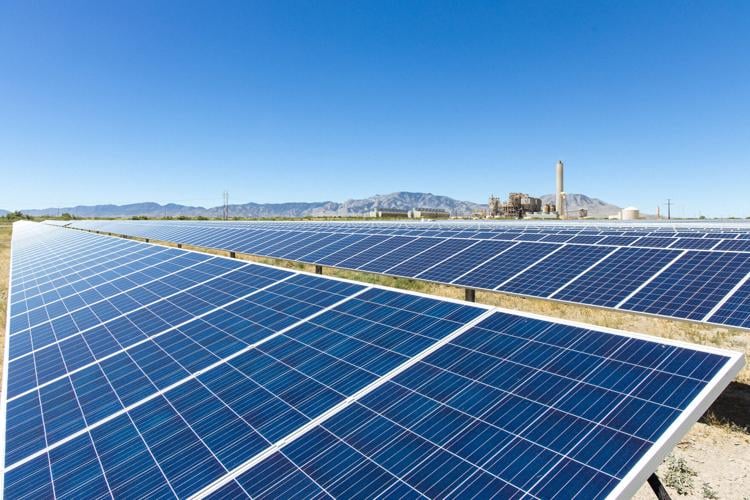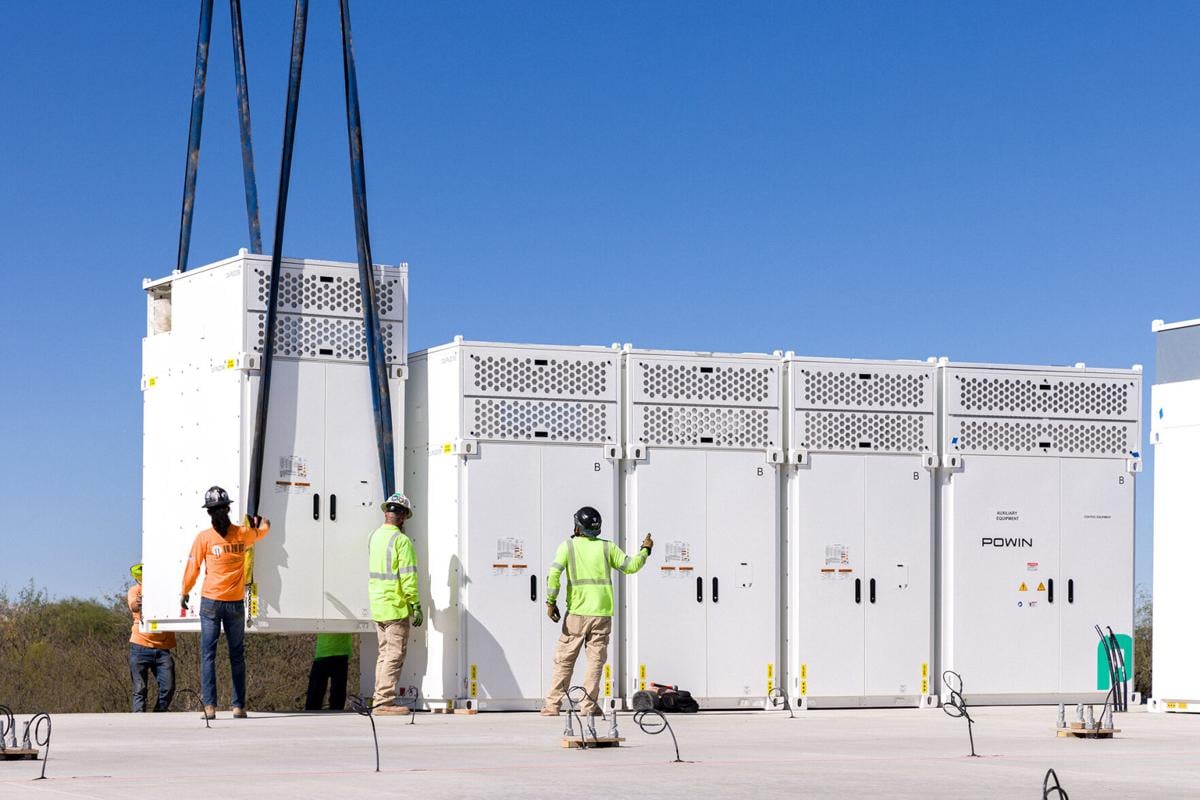Arizona’s rural electrical cooperatives are catching up in the transition from fossil fuels to renewable energy with major new solar and energy-storage projects completed or under way in Southern Arizona.
Arizona Electric Power Cooperative, a nonprofit cooperative that provides electric generation and transmission services to Marana-based Trico Electric Cooperative and five other distribution co-ops, recently announced an agreement to build a massive new solar farm, with battery energy storage, at its coal- and gas-fired Apache Generating Station near Willcox in Cochise County.
And Trico, Sulphur Springs Valley Electric Co-op in Cochise County and Mohave Electric Co-op have all recently added their own solar energy projects with energy storage.
Arizona Electric Power’s Apache Solar II project will have a generating capacity of up to 294 megawatts – enough to serve 54,000 homes — and a 940 megawatt-hour battery facility with that can provide power for four hours after the sun sets.
The co-op’s board in mid-October approved the agreement with affiliates of Clenera LLC and Enlight Co. to develop the project, which Arizona Electric Power said could be under construction sometime next year and be operational by the second half of 2025.
“Our objective is to provide affordable and reliable power, not to make a profit. The Apache Solar II project demonstrates the advantage of smaller utilities coming together on a larger project, to take advantage of economies of scale and substantially reduced costs for all participants and their electric consumers at the end of the line,” said Patrick Ledger, CEO of Arizona Electric Power.
Arizona Electric Power will buy power from the solar and storage project under a 20-year power purchase agreement, Ledger said.
The project cost and the price Arizona Electric Power will pay for power from Apache Solar II is not being disclosed, but Ledger said the pricing is “very competitive” thanks to the project’s large scale, noting that the deal is structured so the co-op can take advantage of a 30% federal tax credit.
Utility-scale photovoltaic solar is now one of the cheapest forms of energy generation, and even without government subsidies can cost less than natural gas generation, according to U.S. Department of Energy data.

Photovoltaic panels installed at Arizona Electric Power Cooperative's Apache Generating Station are part of the original 20-megawatt Apache Solar project, seen here with the power plant in the background. They will be joined by a new, 294MW solar project with storage, which is slated for completion sometime in 2025.
Adding more natural gas
Even so, Arizona Electric Power is adding more natural gas to its generating portfolio.
The co-op plans to add 180MW of new fast-starting gas-fired turbine generators, after gaining approval from the Arizona Corporation Commission in October to finance the generators.
Arizona Electric Power still burns coal at one steam generating unit at Apache, along with one gas-fired turbine generator.
With regulatory approval and financing, Arizona Electric Power plans to add four more gas units at Apache, as well as two gas generators in Mohave County to shore up reliability in Mohave Electric Co-op’s territory, Ledger said.
Ledger said Arizona Electric Power has applied for funding for its solar project through the U.S. Department of Agriculture’s Empowering Rural America program, part of the Inflation Reduction Act that provides $9.7 billion for grants and low-interest loans to rural co-ops for renewable-energy, energy efficiency and carbon-capture projects.
Though the USDA announced in September that the program had received 157 applications for 750 projects totaling twice the program’s value, Ledger said Arizona Electric Power has a good shot at funding as a generation co-op that serves distribution co-ops in many disadvantaged rural areas of Arizona.
“They’re going to have widespread benefits to Arizona because it’s not just benefiting one utility, it’s benefiting a large number of utilities, all not-for-profit,” he said. “We all serve lower income communities, so we think it’s perfect for the program.”
Ledger said while Arizona Electric Power still has no set retirement date for the last coal unit at Apache, the planned projects in the works together with federal funding will help it retire its stranded investment in the coal facilities.
“If that (funding) comes through and helps us to lower our costs and we can spread those costs over a longer period of time, then we’ll be in a pretty good position to close that coal facility well before its contractual retirement,” he said.
New incentives available
In addition, the Inflation Reduction Act also allows the nonprofit co-ops to get direct payments for federal renewable-energy incentives, since they have no tax liability on which to base renewable tax credits.
To take advantage of the tax credits, co-ops have worked them into deals with developers or set up for-profit entities for projects to reap the tax benefits.
The massive solar farm will be built on retired farmland Arizona Electric Power has acquired over the years as a buffer to the Apache Generating Station, which has operated since 1961.
But even as it adds solar and storage, Arizona Electric Power also is planning to build significant new natural-gas fired generation capacity.
Last month, the Arizona Corporation Commission approved Arizona Electric Power’s request for interim and long-term debt financing up to $170 million to help it construct a 180MW natural gas generation facility at the Apache power plant.
Arizona Electric Power says the new, “fast-ramping” gas units are needed to provide on-demand energy when intermittent renewable energy resources like solar and wind aren’t available, to increase reserve margins and replace aging units.
Ledger said that the gas-turbine generators the co-op plans to install don’t use water to make steam and use the latest technologies to make them energy efficient and limit emissions.
Tucson Electric Power Co. and other investor-owned utilities in the state have also been adding gas-fired units, for similar reasons.
Pushing renewable transition
But environmental groups including the Sierra Club have opposed moves by the utilities to add more gas, which emits about half the carbon dioxide when burned than coal but is still a potent source of other greenhouse gases including methane from production.
Some also cite the volatility of natural-gas prices, which spiked last fall to nearly $9 per million BTU (British Thermal Units) before falling to the $2-$3 range since January, noting that it’s now cheaper to generate power with utility-scale solar than coal and older gas-fired units.
Sandy Bahr, director of the Sierra Club Grand Canyon Chapter, said the group is glad the co-ops are beginning to invest more in renewable energy here in Arizona but still has misgivings.
“They have been slow to transition and are still, unfortunately, putting big dollars into fossil gas and refusing to retire dirty coal,” Bahr said. “The co-ops should recognize that solar plus storage and wind are just better investments, they are cheaper than coal, help to offset the volatility of gas prices, and of course are better for the air, the climate and our health.”

Trico Electric's Chirreon Solar and Battery Storage Facility, north of Tucson, went online in 2022 and is projected to produce enough to power about 3,000 average residential homes each year.
Trico adds storage
Meanwhile, Trico and other Arizona co-ops have been busy building out their own solar and storage systems.
Trico Electric, which serves about 50,000 members in rural parts of Pima, Pinal and Santa Cruz counties, added a 15MW battery storage facility to its 10MW Avion Solar Facility in Marana that went online in May.
Trico also is installing a new 10MW, 40MWh battery system adjacent to its Sahuarita distribution substation that is expected to be operational by end of this year.
Last year, Trico turned on its Chirreon Solar and Battery Storage Facility near Catalina, which has a generating capacity of 10 megawatts of photovoltaic power and 15MW of battery storage.
Trico also has a small, 227-kilowatt photovoltaic “Sun Farm” it installed at its Marana headquarters campus way back in 2011.
Trico CEO Brian Heithoff said solar and storage figures prominently in the co-ops future generation plans, noting that more projects are in the works but the co-op is moving cautiously as costs allow.
“We’re really trying to thread the need as far as what is best for the cooperative, what’s best for our members, and ultimately we want to ensure reliability and cost-effective rates,” Heithoff said.
“Having a balanced generating portfolio is a cornerstone of Trico’s resource plan, and obviously solar and storage are a large part of the plan,” he said.
Since 2010, the percentage of power Trico gets from renewables has jumped from less than 1% to 33%, while its coal generation has dropped from 75% to 30%, and gas generation has increased to 30% from 20%.
Trico has a goal to cut its carbon emissions by 50% by 2032.
Though it’s perhaps counterintuitive, Heithoff said, fast-ramping natural gas units are vital to the co-op’s solar buildout.
“When the sun goes down, we have a need to really ramp up and our current units can’t do that. It makes sure we have reliability all hours of the year, and batteries are part of the solution, too,” he said.
Sulphur Springs
Willcox-based Sulphur Springs Electric Cooperative, which serves about 60,000 customers in Cochise, Graham, Pima and Santa Cruz counties including Sierra Vista and Benson, recently completed a major solar and storage project at McNeal in Cochise County.
Sulphur Springs’ McNeal Solar Farm, developed by Silicon Ranch, includes a 20MW photovoltaic array and an 80MWh battery system that will meet the power needs of about 3,000 average households, with batteries providing 20MW of power for four hours.
Jason Bowling, CEO of the co-op, said the solar field will reduce the amount of power that the member-owned utility will need to purchase from other sources.
“We’re excited to bring this energy source online and increase the amount of affordable electricity that will be provided to our members,” Bowling said.
Mohave Electric
Bullhead City-based Mohave Electric Cooperative recently turned on a 23MW solar farm with 60MWh of storage constructed by EDPR NA Distributed Generation and Prometheus Power.
Mohave’s first solar-plus-storage system will provide renewable power, mitigate peak-period energy use, and stabilize energy costs for its 36,700 members, the co-op said.
“This project demonstrates MEC’s proactive planning to increase reliability, meet renewable energy mandates, and support the overall electrical grid,” Mohave Electric CEO Tyler Carlson said.
Construction under way in 2022 on the Chirreon facility north of Tucson. The 90-acre solar and battery storage project, by Trico Electric Cooperative, went online in the fall of 2022. Video by: Mamta Popat







